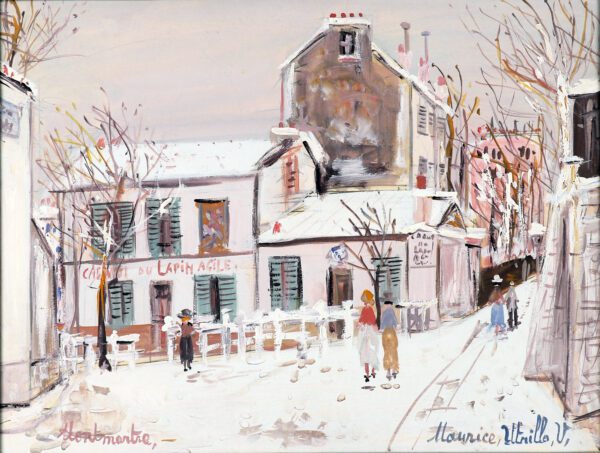“Le Lapin Agile sous le neige”, 1930
Gouache on paper, 24 x 32 cm
signed lower right ‘Maurice Utrillo, V,’
Located lower left ‘Montmartre’
"*" indicates required fields
Notes
Maurice Utrillo’s life could not have been more bohemian. A romantic concept, la vie bohème was for many people who lived such an existence in Paris of the late 19th and early 20thcentury far less dazzling in reality. Born to the former circus acrobat turned artist’s model and eventually avant garde artist, Suzanne Valadon (she was only 18 at the time) Utrillo never knew who his father was.
When he was 21, Utrillo took up painting at the encouragement of his mother, who had learned to paint while posing for artists like Morisot, Toulouse-Lautrec, Renoir and Degas and had become a skillful artist in her own right. Eventually, the two shared a studio in Montmartre. By 1909 Utrillo was painting extraordinary Post-Impressionist street scenes and was exhibiting at the Salon d’Automne in Paris and, by 1912, in the Salon des Indépendants. It was a period marked by a radical bleaching of his palette as white became his predominant tone, and he began mixing paint with glue and lime, producing masterpieces such as La Rue Norvins à Montmartre (c.1910).
By 1910, he had achieved considerable critical acclaim, having developed a style of landscape painting that combined features of Post-Impressionism and Cubism. His landscapes and cityscapes earned him lucrative sales and national notoriety, including the Cross of the Legion of Honor from the French government in 1928. In 1935 he married Lucie Valore (1878-1965), the widow of the art collector and –dealer Pauwels, and moved to Le Vésinet, just outside of Paris, where he drew the present gouache. It has all the characteristics of his later, coloured period, from 1922-1955: lively tones and predominant gays.
Despite having been shunned by the French artistic establishment during much of his career, he is considered one of the pioneers of The School of Paris, the pre-World War I, modern artistic movement characterized by experimentation and pluralism.
Maurice Utrillo produced many paintings of street scenes in the Montmartre district of Paris. He is best known for his White Period (1909–14), during which he used white zinc, sometimes mixed with plaster, to convey the aging walls and deteriorating houses of his cityscapes. Socially withdrawn and a recovering alcoholic, Utrillo would often work from tourist postcards to produce his work.
Le Lapin Agile
The Lapin Agile was bought in the early twentieth century by the cabaret singer, comedian, and nightclub owner Aristide Bruant to save it from demolition. The Lapin Agile became a favourite spot for struggling artists and writers, including Picasso, Modigliani, Apollinaire, Roman Greco and Utrillo. Pablo Picasso’s 1905 oil painting, Au Lapin Agile (“At the Lapin Agile”) helped to make this cabaret world-famous.
In 1993 American comedian and entertainer, Steve Martin, wrote a play, Picasso at the Lapin Agile, which had a successful run in Chicago, Los Angeles, and elsewhere. The play depicted an imagined meeting in 1904 between Pablo Picasso and Albert Einstein at the Lapin Agile.
The Lapin Agile is located in the centre of the Montmartre district in the 18th arrondissement of Paris, behind and slightly northwest of Sacre Coeur Basilica. Since this was the heart of artistic Paris at the turn of the twentieth century, there was much discussion at the cabaret about “the meaning of art”.
Provenance
- Galerie Hopkins Custot, Paris, 2006
- Private collection, Belgium
- Douwes Fine Art, Amsterdam
Expertise
Certificate of authenticity by Mr Gilbert Pétridès, dated 25 January 1989. According to the sale record from Galerie Hopkins Custot in 2006, however the original certificate is not present.





